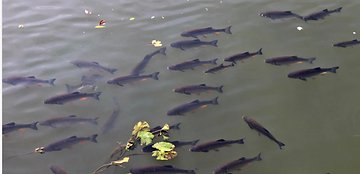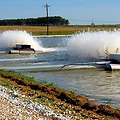
Aquaculture Solutions of East Mississippi

What Will Grass Carp Eat?

Grass Carp will eat certain plant species preferentially. They generally provide excellent to fair control of American Elodea (Elodea Canadensis), Bushy Pondweed (Najas spp.), Stonewort (Chara / Nitella spp.), Waterstarworts (Callitriche spp.), Waterstargrass (Heterantheradubia), Slender Spikerush (Eleocharis spp.), Salvinia spp., Hydrilla (Hydrilla verticillata), Coontail (Ceratophulummdemersum), Bladderwort (Utricularia spp.), Duckweed (Lemna spp.), Watermeal (Wolffia spp.), Water Milfoil (Myriophyllum spp.) Curly Leaf Pondweed (Potamogetoncrispus) and Floating Leaf Pondweeds (Potamogeton spp.). Typically Grass Carp will not feed on the following plants unless everything else in the waterbody has been consumed or eliminated; Spatterdock / Yellow Pond Lilly (Nupharadvena), Watershield (Braseniaschreberi), Waterlilies (Nymphaea spp.), Water smartweed (Polygonum spp.), Cat-tails (Typha spp.), Pithophora algae (Pithophora spp.), Alligatorweed (Alternanthera philoxeroides), Water Primrose (Ludwigia spp.), Lyngbya algae (Lyngbya spp.), Water hyacinth (Eichhorniacrassipes), Water lotus (Nelumbium / Nymphaea spp.), Pennywort (Centellaasiatica), Parrot’s feather (Myriophyllumaquaticum).
Grass carp grow rapidly under favorable conditions. Food consumption rates are influenced by temperature, age, and size of fish, dissolved oxygen, and plant species. Grass carp consume vegetation intermittently at temperatures as low as 37 F. They eat steadily at 50 to 60 F, with optimal consumption at temperatures between 70 and 86 F. Fish weighing 2 to 2.5 pounds can consume more than their body weight each day (in some cases up to 300%)!

Southern Naiad

Torpedograss

Duckweed

Water Primrose

New ponds have clear water so weeds can quickly become established.

Aquatic vegetation can increase the levels of nitrogen and phosphorus causing a decrease in water quality. Too much of these nutrients cause the algae bloom to become much heavier increasing the risk for bloom die-offs.
Not Just Weeds

Infestations of the Trematode Bolbophorus sp. in Channel Catfish



Jeffery S. Terhune, David J. Wise, Jimmy L. Avery, Lester H. Khoo* and Andrew E. Goodwin**
This is a publication from the Thad Cochrane National Aquaculture Center, Stoneville MS
Digenetic trematodes, which are spread by Ramshorn snails, can cause costly problems in Mississippi catfish ponds, including slow fish growth, susceptibility to diseases and fingerling death. Weeds along the pond banks make an ideal habitat for Ramshorn snails to thrive and reproduce.


Stocking Rates for Grass Carp
Generally, grass carp prefer the soft, tender tips of young, growing plants and submerged vegetation. It is known that grass carp consume literally hundreds of aquatic plant species. It is probably safe to say that if they are hungry and deprived of preferred vegetation, they will consume any plant material they can find, including terrestrial plants overhanging the water.
CALL (662) 361-8602
Justin Saul
How many Grass Carp should you stock?
Often managers stock too few fish to control the problem. If grass carp are over-stocked they simply have little to eat and do not grow

New Ponds & Minor Weeds
Less Then 10%
3 -5 Grass Carp per surface acre.

Moderate Weeds
10% -30%
10 - 12 Grass Carp per surface acre

Severe Weeds
30% - 50%
12 - 15 Grass Carp per surface acre
If the pond is more then 50% covered or if the situation is critical, 20 Grass Carp or more per acre would be recommended. A bigger Grass Carp, 12"+ may be another option to help clean a pond out quicker.

While grass carp live many years, their effectiveness for vegetation control decreases significantly after 5 to 7 years. At this age their growth rate and food consumption slow. Ponds usually need to be restocked with grass carp every 5 to 7 years; or each year, 20 percent of the original number can be restocked to offset mortality and loss due to seining.
Stocking rates should be based on grass carp vegetation preferences and the biomass of plants in a pond. Many submerged plants can have a very high biomass, partly because they are 90 to 95 percent water. Species such as hydrilla, southern naiad, chara, elodea and coontail can have a total wet biomass of more than 10 tons per acre.

Grass carp spawn naturally only in rivers with high water flows and appropriate temperature. The water/current velocity must be sufficient to keep the semi-buoyant eggs suspended as they are carried downstream. If the eggs fall to the bottom, they will succumb to siltation and low dissolved oxygen. It is estimated that the eggs must remain suspended for 20 to 40 hours, which means that they may travel 30 to 110 miles (50 to 180 km), depending on water velocity, before hatching. Therefore, grass carp cannot spawn in ponds.